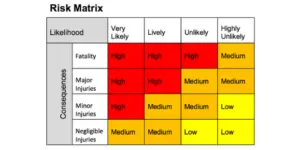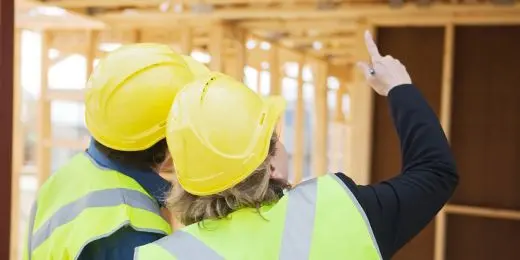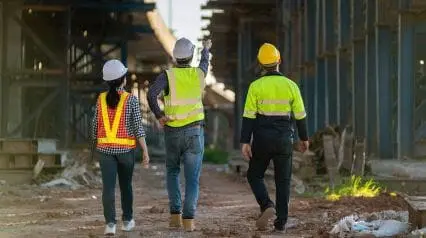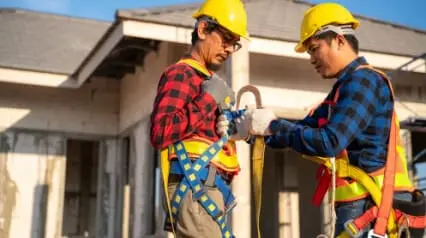What is Take 5 Safety?
Take 5 safety is a 5-step procedure construction workers use to prevent accidents and overall make their working environments safer. Other industries that benefit from implementing take 5 safety are manufacturing, repair & service, and mining. Following take 5 safety involves regularly conducting quick safety checks before starting work.
What are the Take 5 Safety Steps?
The take 5 safety steps are:
- Stop and think
- Look and identify
- Assess the risk
- Control hazards
- Monitor hazards
Stop and Think
The key focus of this take 5 safety step is to stop whatever you’re doing, if you are conducting take 5 safety in the middle of work, or to not proceed first, if you have yet to begin work.
The basis for this interruption or pause is to encourage mindfulness about the task at hand. Especially important for experienced workers, this 5-minute or less allocation for just thinking very carefully about what is to be done can save them from committing costly mistakes and incurring major injuries.
Components of the stop and think 5 safety step can include the following:
- Task/Activity – What will you be doing?
- Equipment/Machinery – What will you use to accomplish your task?
- Materials/Supplies – What will you be handling?
- People – Other than yourself, who is involved in the completion of the task?
- Place – Where will you be doing this activity?
Look and Identify
This take 5 safety step involves looking around your workplace and identifying hazards.Hazards are aspects of your work or your workplace which could possibly put you in danger.
In the look and identify take 5 safety step, focus on listing down and describing anything you see or notice that is unsafe. No matter how small or minor you think an issue is, take note of it to continue to the next step.
Assess the Risk
After generating a comprehensive list of hazards, assess the risk of each hazard based on how likely it is to contribute to you or someone else being injured and the severity of the possible injury. Taking into consideration these two characteristics of a hazard helps determine its overall risk rating.
While you can use your own judgment regarding a hazard’s level of risk through an examination of its likelihood and consequences, it may also be helpful for you to use a risk assessment matrix like the one below:
Control Hazards
Unlike the previous take 5 safety steps, controlling hazards is action-oriented and begins with asking “What can I or someone else specifically do to reduce the risk of this hazard?” It is essential to ask this question first before speculating on “What needs to be done?”
Since take 5 safety is geared towards immediate hazard control, acting on the best solution available to you in the moment is better than not doing anything at all to reduce a hazard’s risk.
Monitor Hazards
After you have done what you can to control all hazards, you may proceed with work. However, remember to monitor the hazards you have identified as you work. It is possible that the control measure you implemented is insufficient or inappropriate for a particular hazard.
Additionally, it is possible that a specific hazard only emerges when you are in the midst of work as a by-product or a result of the activity. While ideally you should have identified them in the second take 5 safety step, it is easy to miss hazards that you don’t already see.
Improve your EHS Management
Cultivate a safe working environment and streamline compliance with our EHS solutions.
Explore nowTake 5 Safety Templates
Unlike paper forms, digital templates guide workers through the take 5 safety steps with clearly indicated response types such as multiple choice, annotations, photos, text answers, and checkboxes. Supervisors can also include instructions in the take 5 safety template to create an interactive, easily reusable take 5 safety booklet.
Take 5 Safety Risk Assessment Template
Use this digital template before starting work. Identify hazards in detail by selecting the hazard type, attaching photo evidence with annotations, and describing the hazard. Prioritize which hazards to attend to first based on risk level. Input what control measure you plan to take and sign-off.
Take 5 Safety Checklist
Use this digital checklist to identify site hazards covered by the SWMS (Safe Work Method Statement). For hazards not covered in the SWMS or if not using a SWMS, describe the hazard, its risk rating, and the control measures. Input references from the SWMS and SWI (Safe Work Instruction), if applicable. Check if the control measures are effective at reducing risk to an acceptable level by assessing the overall risk rating of the task with the controls in place.
Create Your Own Take 5 Safety Template
Eliminate manual tasks and streamline your operations.
Get started for FREESafe Work Method Statement
A safe work method statement is a document outlining high-risk construction work (HRCW) activities, their associated hazards, and the control measures being implemented to mitigate risks. Preparing a safe work method statement is required for all Australian businesses carrying out the following HRCW activities:
| High Risk Construction Work Activities | ||
| Involves: | Carried out in: | Carried out on: |
| diving work | a confined space | or adjacent to a road, railway, shipping lane or other traffic corridor in use by traffic other than pedestrians |
| a risk of a person falling more than 2 m | a shaft or trench deeper than 1.5 m or a tunnel | or near pressurised gas mains or piping |
| disturbing asbestos | an area of a workplace where there is any movement of powered mobile plant | or near chemical, fuel or refrigerant lines |
| tilt-up or precast concrete | an area that may have a contaminated or flammable atmosphere | or near energised electrical installations or services |
| the use of explosives | areas with artificial extremes of temperature | a telecommunication tower |
| demolition of an element of a structure that is load-bearing | or near water or other liquid that involves a risk of drowning | |
| demolition of an element of a structure that is related to the physical integrity of the structure | ||
| structural alteration or repair that requires temporary support to prevent collapse | ||
Safe Work Method Statement (SWMS) Templates
A safe work method statement (SWMS) template takes the time and hassle out of preparing and distributing the SWMS to workers across sites. With a digital SWMS template, you can take advantage of different formats such as annotated photos, text descriptions, and multiple choice questions to communicate exactly what risks are involved in the HRCW activity and what safety officers are doing to mitigate those risks.
Safe Work Method Statement (SWMS) Template
Use this digital template when performing any of the high-risk construction work activities to document the tasks to be performed, the hazards involved, and the controls. Enter a description of the job and the task. Take a photo as evidence that a HRCW activity is being carried out. Select the HRCW activity from a drop down menu.
Construction Safe Work Method Statement (SWMS) Template
Use this digital template to describe the HRCW activity. Input relevant details such as the employer/contractor, the personnel responsible for monitoring the HRCW activity, the codes of practice/standards consulted, and the maintenance checks required for the HRCW activity. Describe each hazard and the corresponding control measure.
Standard Operating Procedure
A standard operating procedure or SOP is a list of steps and instructions to help workers perform tasks correctly and safely. While the main focus of a standard operating procedure is to comply with state regulations and industry best practices, it can also be used as an accident prevention tool. For businesses in the construction industry, SOPs help ensure that each site has a safe working environment.
Standard Operating Procedure Templates
Site managers can use a SOP template as the basis for their own customized set of standard operating procedures. While the SOPs of businesses in the same industry and state will have similarities, ultimately, the exact wording and components of a standard operating procedure are highly dependent on the person/s in charge of creating it.
Construction SOP Template
Use this digital template to ensure proper (personal protective equipment), hazard identification, and workers sign-off. At each step, take a photo and add a description for further clarification. Promote worker awareness of hazards associated with the SOP. Verify that a take 5 safety has been done and include comments from safety managers, clients, and company management.
Management of Change (MOC) Procedure Template
Use this digital template to identify and control occupational health and safety risks brought by organizational changes. Determine changes in operational procedures and the risks they may cause. Comply with regulations, standards, and client requirements. Include details on who initiated the change, the proposed date of implementation, and whether the change is permanent or temporary.
Field Level Hazard Assessment
A field level hazard assessment or FLHA is a shorter version of take 5 safety, in that it features three of the five steps in take 5 safety: Stop, Look, and Control. However, while FLHA lacks take 5 safety’s emphasis on risk analysis and monitoring, it can still be an immensely helpful tool for the people it was designed for, namely field workers.
Field level hazard assessments empower field workers to minimize health and safety risks at the onset through developing the habit of task-control-hazard association.
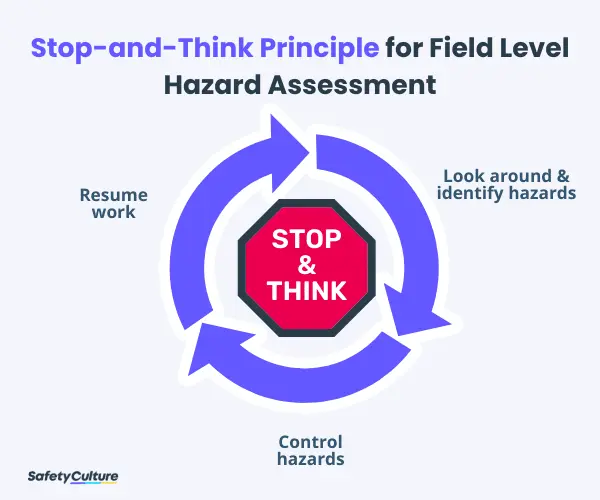
Stop-and-Think Principle for Field Level Hazard Assessment
Field Level Hazard Assessment Templates
FLHA templates are easy-to-use guides for field workers to practice immediate hazard identification and control. They also serve as automated documentation of changes in tasks. Field workers should use these digital templates prior to and during task execution.
Field Level Hazard Assessment Template
Use this digital template to discuss the tasks to be done, specific hazards identified with photo evidence, and the hazard control measures taken. Select the type of hazard associated with a task update, a new task, the arrival of new workers, and changes in job site condition. Record all of these in real-time and validate the assessment with a digital signature.
Field Level Hazard Assessment Checklist
Use this digital checklist to evaluate your work area and tasks including the availability of PPE, whether a task requires special training, and the tools and equipment provided to you. Provide descriptions and identify hazards for each task. Use the risk assessment matrix within the checklist to determine the level of risk.
Construction Risk Assessment
A construction risk assessment is a critical examination of the overall safety of the site. Site managers should perform regular construction risk assessments to ensure that working conditions comply with safety regulations. The main consequence of not doing so is a higher number of accidents, resulting in heavy project delays and expensive medical rehabilitation for workers with major injuries.
The most fatal risks in construction, otherwise known as the Fatal Four, are falls, struck-by object, electrocution, and caught in/between objects.
| Fatal Four | ||||
| Risks | Falls | Struck-by Object | Electrocution | Caught in/between Objects |
| Hazards | Lack of personal fall arrest systems | Falling debris | Faulty wires or equipment | Running machinery and equipment (unguided moving parts) |
| Poor general Safety Equipment | Moving equipment parts | Unsafe location of electrical outlets | Buried in or by (cave-ins/trenching) | |
| Improper use of ladders or scaffolds | Improper use of extension cords | Rolling, sliding, or shifting objects (example: a truck frame and a hydraulic bed that is lowering) | ||
Construction Risk Assessment Templates
A digital template is a convenient tool site managers use to conduct multiple risk assessments. Unlike a paper form, a construction risk assessment template is easily duplicated and adjusted based on the requirements of each site and/or project. Another reason to use a digital template is that it automatically generates a report the moment you finish your assessment.
General Risk Assessment Template
Use this digital template to assess the risk of a particular procedure, task, or site. Add and take photos of multiple hazards. Get the initial and residual risk rating by using the risk assessment matrix reference included in the template. Select the best control measure from a dropdown list based on the hierarchy of controls reference also included in the template.
General Construction Risk Assessment Template
Use this digital template to document any potential hazards and risks on-site. Provide a brief description of each hazard and identify the procedure and equipment involved (i.e. working at heights, scaffolding, PPE, LOTO procedures, crane/ forklift etc.). Set the appropriate control measures and assign them to different team leaders through the Actions feature.
Follow Take 5 Safety with SafetyCulture Construction Solutions
The SafetyCulture Platform is a mobile construction app built for inspections, observations, issue capturing, and collaborative actions. It was recently awarded as the Best SaaS Product for Health & Safety or Risk Management. With SafetyCulture, following take 5 safety is simple and easy. Take a look below to see how SafetyCulture features complement each take 5 safety step:
For Step 1: Stop and Think
- Schedule the take 5 safety procedure for everyday with recurring inspections
- Get SMS and in-app reminders to perform the take 5 safety steps
For Step 2: Look and Identify
- Flag safety issues instantly for accident prevention
- Take and annotate a photo of each hazard identified
For Step 3: Assess the Risk
- Conduct risk assessments and other safety inspections on a mobile app
- Customize risk assessment templates to fit the needs of each site/project
For Step 4: Control Hazards
- Create immediate actions, set the priority level, and assign a due date
- Ask team members for their input and/or assistance from within an action
For Step 5: Monitor Hazards
- Follow-up on actions created in the previous step and update their progress
- See the bigger picture in detail with analytics and review previous take 5 safety’s

